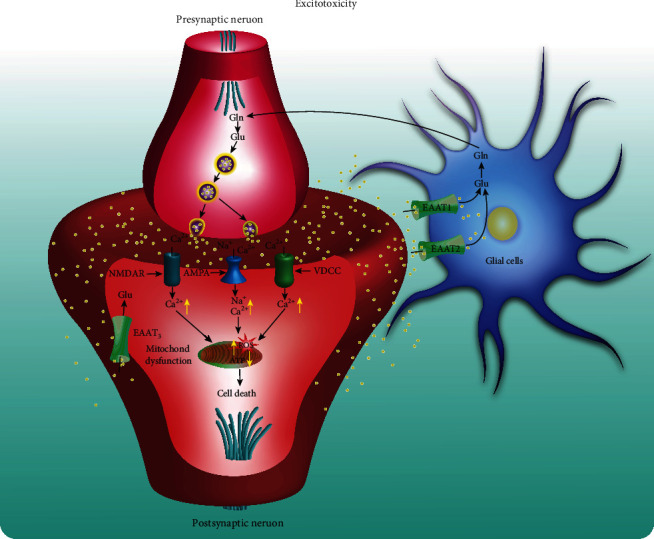Figure 4.

The role of excitotoxicity in neurodegenerative diseases. In presynaptic neurons, glutamate (Glu) is generated through the conversion of Glutamine (Gln) with the action of glutaminase. Glu is stored in the vesicles by vesicular glutamate transporters (vGLUTs). Then, Glu is released from the vesicles and out of presynaptic neurons owing to the depolarization of the presynaptic membrane. Then, Glu binds with the ionotropic glutamate receptors (iGluRs), such as N-methyl-D-aspartate (NMDA) and α-amino-3-hydroxy-5-methyl-4-isoxazole propionic acid (AMPA) receptors in the postsynaptic membrane, and generates an action potential. The binding of Glu with AMPA results in Na+ influx and consequent membrane depolarization and opening of voltage-dependent Ca2+ channels (VDCC). Meanwhile, the binding of Glu with NMDA receptors (NMDARs) leads to the opening of the NMDA receptor channel under depolarizing conditions, resulting in large amounts of Ca2+ influx. Finally, the increased levels of cytoplasmic Ca2+ induce the uptake of Ca2+ uptake into the mitochondria, which then induces the production of reactive oxygen species (ROS) and decreases ATP levels, ultimately resulting in neuronal cell death. The excitatory amino acid transporter 3 (EAAT3) is a transporter of Glu present at the postsynaptic neuronal element. In addition, the excessively released Glu in the synaptic cleft is transported into astrocytes through the EAAT1 and EAAT2 transporters. In astrocytes, Glu is recycled and converted to Gln which is transported to neurons and converted into Glu again.
